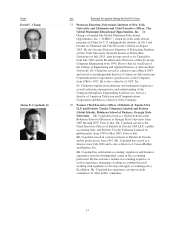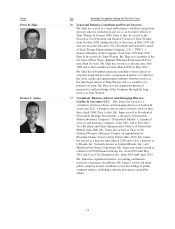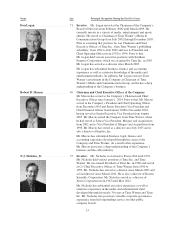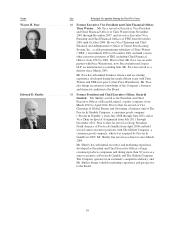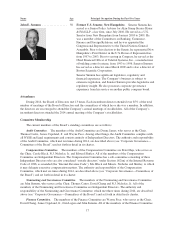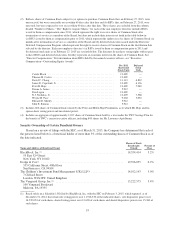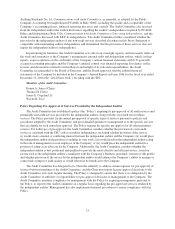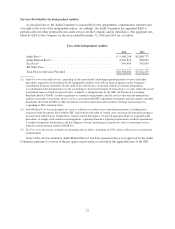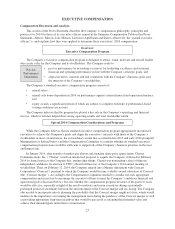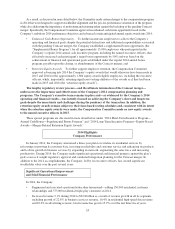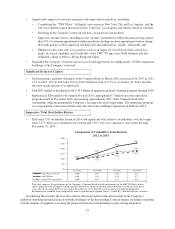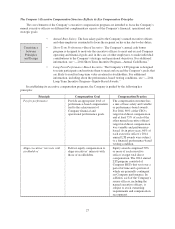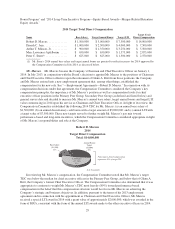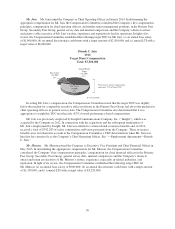Time Warner Cable 2015 Annual Report Download - page 29
Download and view the complete annual report
Please find page 29 of the 2015 Time Warner Cable annual report below. You can navigate through the pages in the report by either clicking on the pages listed below, or by using the keyword search tool below to find specific information within the annual report.
EXECUTIVE COMPENSATION
Compensation Discussion and Analysis
This section of the Proxy Statement describes the Company’s compensation philosophy, principles and
practices for 2014 for those of its executive officers named in the Summary Compensation Table in this Proxy
Statement—Messrs. Marcus, Jain, Minson, Lawrence-Apfelbaum and Stern (collectively, the “named executive
officers”)—and explains how they were applied to determine these executives’ 2014 compensation.
Overview:
Executive Compensation Program
The Company’s executive compensation program is designed to attract, retain, motivate and reward leaders
who create value for the Company and its stockholders. The Company seeks to:
Pay-for-
Performance
Orientation
• pay for performance by rewarding executives for leadership excellence and sustained
financial and operating performance in line with the Company’s strategic goals; and
• align executives’ interests and risk orientation with the Company’s business goals and
the interests of the Company’s stockholders.
The Company’s standard executive compensation program consists of:
• annual salary;
• annual cash bonus dependent in 2014 on performance against certain financial and operational metrics;
and
• equity awards, a significant portion of which are subject to complete forfeiture if performance-based
vesting conditions are not met.
The Company believes that the program has played a key role in the Company’s operating and financial
success, which in turn has helped drive strong operating results and total stockholder return.
Special 2014 Compensation Considerations and Programs
While the Company believes that its standard executive compensation program appropriately incentivizes
executives to achieve the Company’s goals and aligns the executives’ interests with those of the Company’s
stockholders in most circumstances, the extraordinary events that occurred in late 2013 and early 2014 prompted
Management (as defined below) and the Compensation Committee to consider whether its standard executive
compensation program alone would be sufficient to support all of the Company’s business priorities in the near
and longer term.
In January 2014, after months of market speculation and attendant share-price appreciation, Charter
Communications, Inc. (“Charter”) made an unsolicited proposal to acquire the Company, followed in February
2014 by formal notice to the Company that, among other things, Charter was nominating a slate of thirteen
independent candidates for election to TWC’s Board of Directors at the Company’s 2014 annual meeting of
stockholders. Then, on February 12, 2014, the Company entered into a Merger Agreement with Comcast
Corporation (“Comcast”) pursuant to which the Company would become a wholly owned subsidiary of Comcast
(the “Comcast merger”). Accordingly, the Compensation Committee needed to consider not only appropriate
compensation and incentives to encourage the executive officers to meet the Company’s ambitious financial and
operational goals (discussed below), but also whether the compensation program structure of the past few years
would be effective, especially in light of the need to motivate and retain executives during a potentially
prolonged period of uncertainty between the announcement of the Comcast merger and its closing. The Company
also needed to incorporate into its planning the possibility that the Comcast merger might not close, which would
underscore the importance of retaining the management team during the pendency of the Comcast merger as well
as providing appropriate long-term incentives that would be perceived as retaining their intended value and
achieve their intended goals under those circumstances.
23


